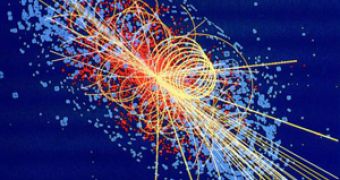Based on a prediction made more than three decades ago, CLEO physicists conducting a high-energy experiment claim to have discovered a new sub-atomic particle named 'charmed-strange meson'. The discovery of a new type of meson may be a pivotal point in particles physics and cosmology in special, by observing a new way through which elementary particles of atoms, namely protons and neutrons, can be created.
The charmed-strange meson is extremely unstable and decays spontaneously into protons and anti-neutrons. The discoverer of the particle is John Yelton, CLEO collaborator and physicist at the University of Florida. "It's the sort of thing that, for many years, people have known should happen. What we have done is show that id does, and how often," says Yelton in a press release.
The experiments were conducted at the Cornell Electron Storage Ring accelerator, or CESR for short, by colliding electrons with their anti-particles, positrons, at very high energies - 3 to 5 billion electron volts. The short-lived particles resulting from the decay represented the main focus of the experiment, being captured and detected by the CLEO large experimental detector.
For more than 30 years, physicists around the world studied the charmed mesons without ever detecting one, as charmed-strange mesons exist for only one-trillionth of a second before decaying into a proton and neutron, a task made even more difficult by the fact that, out of the total number of electron-positron collisions, only 10 percent result in the creation of a proton-anti-neutron pair. In fact, the experiment was only capable of detecting the proton, while the anti-neutron evaded direct detection. However, it was later identified by inferring its presence from the energy and momentum of other particles created during the collisions.
To be fair, it should be probably noted that Yelton has detected at least 13 charmed-strange mesons resulting in a decay into protons and anti-neutrinos, from a sample of a couple of millions of different collisions, by using detection strategies previously developed at the Syracuse University, for the detection of two other elusive particles: the neutrino and the muon.
Spokesperson of CLEO, physicist David Asner from Carleton University, stated: "Observations of these rare decays has the promise of increasing our understanding of the underlying mechanisms of how the worlds is put together." The CLEO facility became operational in 1979, at the time being equipped with the most powerful particle accelerator in the world, CESR.
The newly designed particles accelerator, or so-called colliders, such as the Large Hadron Collider, tend to focus the attention of the particle physics community towards high energy collisions, albeit through his work Yelton proved that there is still much to learn from experiments with low-energy particle accelerators.

 14 DAY TRIAL //
14 DAY TRIAL //